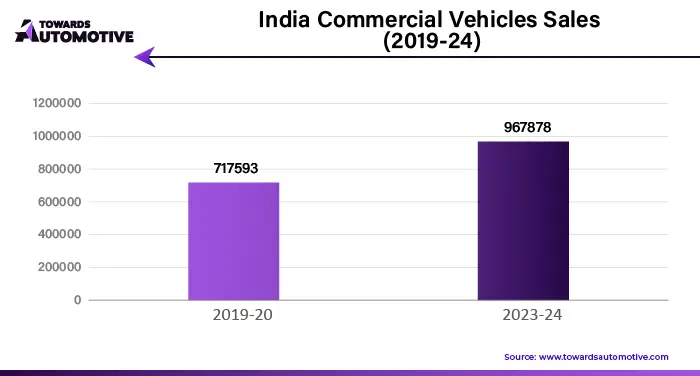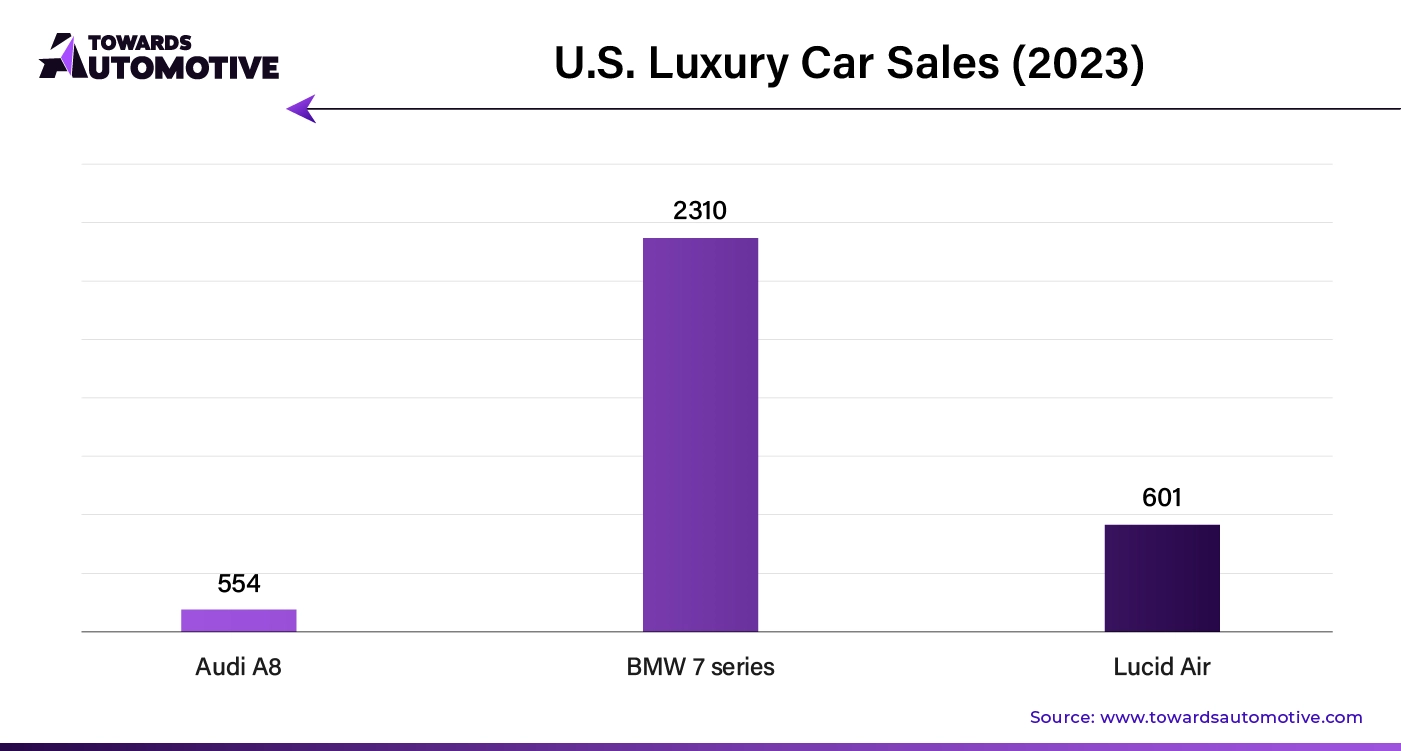September 2025
The global automotive air spring market size is calculated at USD 1.90 billion in 2024 and is expected to be worth USD 3.15 billion by 2034, expanding at a CAGR of 4.69% from 2024 to 2034.

Unlock Infinite Advantages: Subscribe to Annual Membership
The automotive air spring market is experiencing robust growth, driven by increasing demand for enhanced ride comfort, improved vehicle handling, and greater load-carrying capacity. Air springs, which use compressed air to support the vehicle’s weight and absorb shocks, offer superior performance compared to traditional metal coil springs. This technology allows for adjustable ride height and better adaptability to varying loads, making it highly sought after in both passenger cars and commercial vehicles. The growing focus on vehicle safety and luxury is further propelling the market, as air springs provide smoother rides and reduced vibrations, enhancing overall driving experience.
Additionally, advancements in air spring technology, such as more durable materials and advanced control systems, are contributing to their broader adoption. The increasing prevalence of air suspension systems in high-end vehicles and the growing trend towards electric and autonomous vehicles also support market growth, as these applications benefit significantly from the advantages offered by air springs. Moreover, expanding automotive production in emerging markets and the rising demand for commercial vehicles with enhanced load management capabilities are further driving the adoption of air springs. As vehicle manufacturers continue to innovate and seek ways to improve performance and comfort, the automotive air spring market is poised for continued expansion.
AI is revolutionizing the automotive air spring market by enhancing system performance, reliability, and user experience. Through predictive maintenance, AI analyzes data from air spring sensors to anticipate potential failures and optimize maintenance schedules, reducing unexpected breakdowns and extending component lifespan. Real-time monitoring and adjustment powered by AI allow for dynamic optimization of air suspension settings based on driving conditions and load variations, thereby improving ride comfort and vehicle handling. AI also facilitates seamless integration with other vehicle systems, such as electronic control units (ECUs) and advanced driver-assistance systems (ADAS), ensuring precise control of ride height and suspension dynamics. Additionally, AI-driven data analytics provide valuable insights for manufacturers to refine designs and develop advanced features, while enabling personalized suspension settings based on individual driver preferences. Overall, AI enhances the efficiency and functionality of air spring systems, supporting the automotive industry's push towards more sophisticated and responsive vehicle technologies.
Rising sales of commercial vehicles are significantly driving the growth of the automotive air spring market, as these vehicles increasingly adopt advanced suspension technologies to meet performance and comfort demands. Commercial vehicles, including trucks, buses, and trailers, benefit from air springs due to their ability to manage heavy loads, provide a smoother ride, and improve vehicle stability. As the commercial vehicle sector expands, driven by factors such as increased logistics activities, infrastructure development, and economic growth, the demand for efficient and reliable suspension systems, including air springs, rises accordingly.
Air springs enhance load-carrying capacity and ride quality, crucial for commercial applications where vehicle performance directly impacts operational efficiency and safety. Additionally, the growing focus on reducing vehicle wear and tear, minimizing maintenance costs, and improving fuel efficiency further fuels the adoption of air spring systems. The expanding commercial vehicle market also prompts manufacturers to innovate and integrate advanced air spring technologies, such as electronic control systems and adaptive suspension features, to meet evolving industry standards and customer expectations. As commercial vehicle sales continue to rise, the automotive air spring market is poised for substantial growth, driven by the need for advanced suspension solutions that enhance performance and operational effectiveness in commercial applications.

The automotive air spring market faces several restraints, including high initial costs compared to traditional suspension systems, which can deter budget-conscious buyers. Additionally, the complexity of air spring systems and the need for specialized maintenance and repair can increase overall ownership costs. Limited availability of skilled technicians and service centers for air spring systems further compounds this issue. Moreover, the performance of air springs in extreme weather conditions can sometimes be a concern, potentially affecting their reliability and widespread adoption in diverse environments.
Smart air spring are creating significant opportunities in the automotive air spring market by introducing advanced features that enhance performance, reliability, and user experience. Equipped with sensors and connectivity capabilities, smart air springs enable real-time monitoring and adjustment of suspension settings. This allows for precise control over ride quality, load distribution, and vehicle dynamics, improving overall driving comfort and handling. The integration of smart technology also facilitates predictive maintenance, as these systems can detect and report potential issues before they lead to failures, reducing downtime and maintenance costs.
Additionally, smart air springs offer valuable data analytics that help manufacturers and fleet operators optimize performance and make informed decisions about vehicle maintenance and management. This technology supports the growing trend of vehicle connectivity and automation, aligning with the development of Advanced Driver Assistance Systems (ADAS) and enhancing the overall driving experience. As the automotive industry increasingly adopts smart technologies, the demand for advanced air spring systems is expected to rise, creating substantial growth opportunities in the market. The innovation and efficiency brought by smart air springs position them as a key driver of future advancements in suspension technology.
The single-convolution air springs led the industry. Single-convolution air springs are driving significant growth in the automotive air spring market due to their unique design and performance advantages. Featuring a single, continuous layer of rubber and fabric, single-convolution air springs offer a more compact and lightweight alternative to traditional multi-convolution designs. This streamlined construction enhances their ability to handle high loads while providing superior ride comfort and stability. The reduction in weight and space requirements makes them particularly attractive for applications in passenger cars and commercial vehicles where efficiency and performance are crucial.
Additionally, single-convolution air springs offer improved durability and reliability, with fewer components prone to wear and tear, leading to lower maintenance costs and extended service life. Their simplified design also allows for easier installation and integration into vehicle suspension systems. As manufacturers and consumers increasingly prioritize efficiency, comfort, and cost-effectiveness, the demand for single-convolution air springs is rising. Their benefits align well with current industry trends towards optimizing vehicle performance and reducing operational expenses, contributing to the overall growth of the automotive air spring market.
The front axle suspensions dominated the market. Front axle suspensions are driving significant growth in the automotive air spring market due to their critical role in enhancing vehicle performance and comfort. Air springs used in front axle suspensions provide superior ride quality by effectively absorbing shocks and vibrations from the road, leading to a smoother and more comfortable driving experience. This is particularly beneficial in vehicles that require precise handling and stability, such as luxury cars and heavy-duty trucks. The growing demand for improved vehicle dynamics and driver comfort is accelerating the adoption of air spring systems in front axle applications.
Additionally, air springs in front axle suspensions offer adjustable ride height and load leveling capabilities, which are increasingly sought after in both passenger and commercial vehicles. These features contribute to better handling, safety, and adaptability in various driving conditions. As automotive manufacturers continue to focus on enhancing ride quality and vehicle performance, the integration of air springs into front axle suspensions becomes more prevalent. This trend drives the growth of the automotive air spring market, as these systems align with the industry's emphasis on advanced suspension technologies and overall driving excellence.
The OEM segment dominated the industry. Original Equipment Manufacturers (OEMs) are driving significant growth in the automotive air spring market through their commitment to integrating advanced suspension technologies into new vehicle models. OEMs play a crucial role by specifying and adopting air springs as standard or optional features in their vehicles, thereby influencing market trends and driving demand. As automotive manufacturers focus on enhancing vehicle performance, comfort, and safety, they increasingly turn to air springs for their superior ride quality and adaptability.
Air springs offer benefits such as improved load leveling, adjustable ride height, and reduced road vibrations, which align with the OEMs’ goals of delivering high-quality driving experiences. Additionally, OEMs are investing in research and development to innovate and optimize air spring technologies, further boosting their adoption. The growing emphasis on luxury, safety, and performance in new vehicle models results in a higher incorporation of air spring systems. As OEMs continue to advance vehicle design and engineering, their influence significantly impacts the growth and evolution of the automotive air spring market, driving innovation and expanding market opportunities.
Asia Pacific held the largest share of the automotive air spring market in 2023. Rapid urbanization, economic growth, and the expansion of automotive manufacturing capabilities are key drivers of the automotive air spring market’s growth in Asia Pacific. The region's swift urbanization is creating a surge in demand for construction and commercial vehicles, as infrastructure development projects and urban expansion require robust and reliable suspension systems. Air springs, known for their superior load-carrying capacity and enhanced ride quality, are increasingly being adopted in these vehicles to meet the demands of variable road conditions and heavy loads. Economic growth in Asia Pacific countries is also fueling the automotive sector’s expansion, as rising incomes and improved purchasing power lead to increased vehicle sales and ownership.
This growth includes a rising demand for both luxury and commercial vehicles that offer superior comfort and performance, further driving the adoption of air springs. Additionally, the expansion of automotive manufacturing capabilities in the region, with investments in state-of-the-art facilities and technologies, is enhancing the production and availability of advanced air spring systems. These advancements enable local manufacturers to meet growing demand more efficiently and cost-effectively, while also facilitating innovation in air spring technologies. The combination of rapid urbanization, which increases the need for advanced suspension systems, economic growth, which boosts vehicle sales, and expanded manufacturing capabilities, which supports supply and innovation, collectively drives the robust growth of the automotive air spring market in Asia Pacific. This synergy aligns with the region's broader trends towards improved vehicle performance and infrastructure development, positioning air springs as a key component in the evolving automotive landscape.
North America is observed to grow at the fastest rate in the automotive air spring market. Rising sales of luxury and high-end vehicles, the expansion of commercial vehicle fleets, and increased investment in research and development are pivotal drivers of growth in the automotive air spring market in North America. The growing demand for luxury and high-end vehicles is a significant factor, as these vehicles prioritize advanced suspension systems that enhance ride comfort and handling. Air springs offer superior performance compared to traditional suspension systems, making them a popular choice for high-end vehicles where comfort and stability are paramount. Similarly, the expansion of commercial vehicle fleets, driven by the booming logistics and transportation sectors, boosts the demand for air springs. These systems provide critical benefits for commercial vehicles, such as improved load-carrying capacity, enhanced ride quality, and better adaptability to varying loads and road conditions. As fleet operators seek to optimize vehicle performance and reduce operational costs, air springs become an attractive option.
Furthermore, investment in research and development is fueling innovation in air spring technology. Manufacturers are focused on developing advanced materials, electronic control systems, and more efficient designs, which enhance the performance, durability, and functionality of air springs. This ongoing R&D effort is crucial in meeting the evolving demands of both luxury vehicle markets and commercial applications, driving the adoption of air springs. Together, these factors—rising sales of luxury vehicles, the growing commercial vehicle sector, and continuous technological advancements—are driving significant growth in the North American automotive air spring market, aligning with broader trends towards performance, efficiency, and innovation.

By Spring Type
By Vehicle Type
By Application
By End Market
By Region
September 2025
September 2025
August 2025
August 2025
We offer automotive expertise for market projections and customizable research, adaptable to diverse strategic approaches.
Contact Us